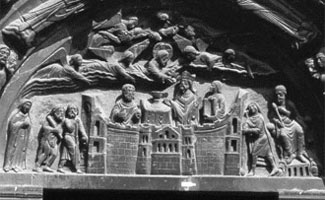Saint Denis
 Saint
Denis was a third century Bishop of Paris and martyr. He is the patron
saint of the French monarchy. Rusticus and Eleutherius were his companions.
According to the legend the prefect, Sissinius, condemned Saint Denis.
After Denis' head was chopped off at Montmartre, Denis bent down, picked up his head, carried
it two miles, to where he wanted to be buried and then fell down dead. The earliest
account of this Saint-Denis is found in The Life of Saint Genevieve, written
in 502. Abbot Hilduin also wrote about the story of Saint Denis:
Saint
Denis was a third century Bishop of Paris and martyr. He is the patron
saint of the French monarchy. Rusticus and Eleutherius were his companions.
According to the legend the prefect, Sissinius, condemned Saint Denis.
After Denis' head was chopped off at Montmartre, Denis bent down, picked up his head, carried
it two miles, to where he wanted to be buried and then fell down dead. The earliest
account of this Saint-Denis is found in The Life of Saint Genevieve, written
in 502. Abbot Hilduin also wrote about the story of Saint Denis:
"The hour of judgment had come; the thugs (bourreaux) threw themselves
on them [the evangelists] beating them cruelly with sticks and dragging them
through the roads to the Hill of Mercury [Montmartre], where, after the most
horrible abuse, the missionaries [athletes] had their heads chopped off with
an ax blow. ... In an astonishing miracle the body of Saint Denis was seen to
rise up and to gather up his head in his own hands as if he was still alive,
raising it up triumphantly and carrying it for a distance of about two Gallic
miles to the place where it presently reposes where the abbey of Saint-Denis
is located. At the sight of this miracle the heathen, terrified, took flight.
But the Christians, in awe, blessed this manifestation of divine power. There
resulted the conversion of a host of the unfaithful."
Anne-Marie Romero, in her book, Saint-Denis: Emerging Powers, discusses the
theories of Lombard-Jourdain. Lombard-Jourdain proposes that Saint Denis was
martyred and buried in Lendit plain North of Paris, which was then part of "Montmartre."
St. Genevieve built the first basilica at the tomb where an oratory had previously
been built. This later became Saint-Denis de la Chapelle. In 627 the bodies
were transferred to the site of the present Saint Denis. The pit found by Formige
was used for the bodies before they were placed in the reliquary. The remains
of the early church at Saint Denis are instead the remains of a church dedicated
to Saint Peter and established there to offset the pagan influence of the nearby
pagan shrine and Druid meeting place.1
For Romero, Lombard-Jordain's proposal leaves unanswered why so many Christians
chose to be buried at Saint-Denis before the translation of his relics. Additionally,
the pagan temple near Saint Denis seems not be the one referred to in Constantine's
panegyric which is currently thought to refer to the Grand
in the Vosges.2
1. Romero, Anne-Marie Romero, Saint-Denis: Emerging Powers.( Paris: Presses
du CNRS (Caisse Nationale des Monuments Historiques et des Sites),1992) pp.
17-18.
2. Romero, pp. 20-21.
 Saint
Denis was a third century Bishop of Paris and martyr. He is the patron
saint of the French monarchy. Rusticus and Eleutherius were his companions.
According to the legend the prefect, Sissinius, condemned Saint Denis.
After Denis' head was chopped off at Montmartre, Denis bent down, picked up his head, carried
it two miles, to where he wanted to be buried and then fell down dead. The earliest
account of this Saint-Denis is found in The Life of Saint Genevieve, written
in 502. Abbot Hilduin also wrote about the story of Saint Denis:
Saint
Denis was a third century Bishop of Paris and martyr. He is the patron
saint of the French monarchy. Rusticus and Eleutherius were his companions.
According to the legend the prefect, Sissinius, condemned Saint Denis.
After Denis' head was chopped off at Montmartre, Denis bent down, picked up his head, carried
it two miles, to where he wanted to be buried and then fell down dead. The earliest
account of this Saint-Denis is found in The Life of Saint Genevieve, written
in 502. Abbot Hilduin also wrote about the story of Saint Denis: